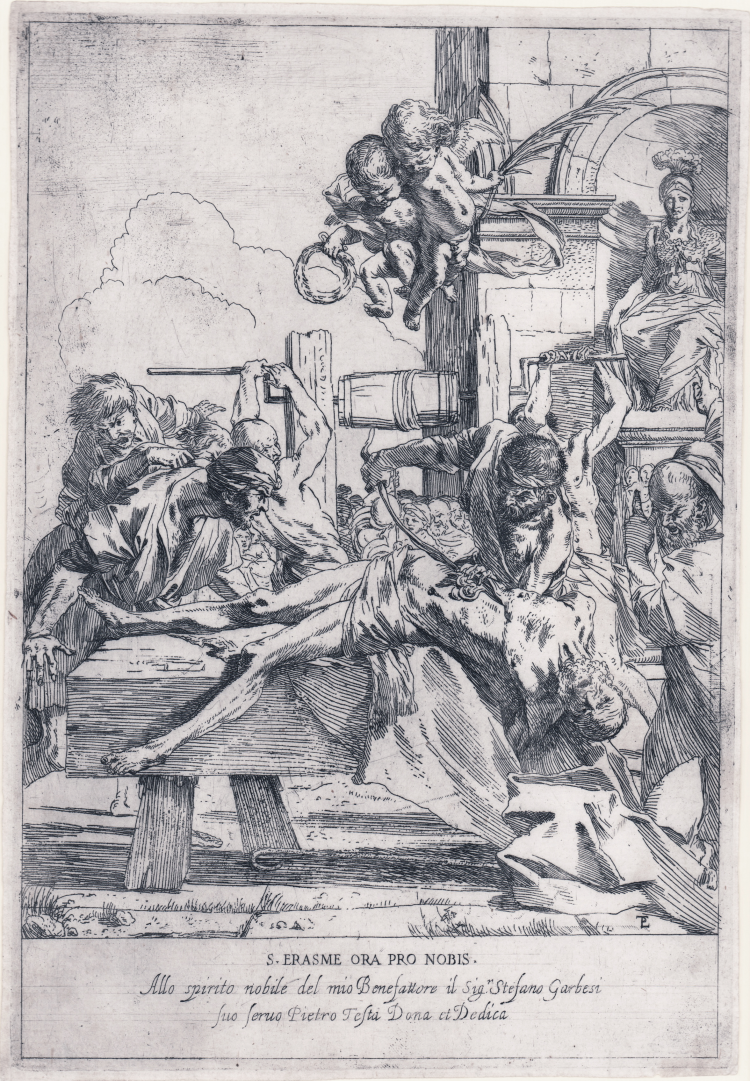




| Reference: | S30463 |
| Author | Pietro TESTA detto "Il Lucchesino" |
| Year: | 1630 ca. |
| Measures: | 190 x 280 mm |



| Reference: | S30463 |
| Author | Pietro TESTA detto "Il Lucchesino" |
| Year: | 1630 ca. |
| Measures: | 190 x 280 mm |
Etching, circa 1630 monogrammed in plate lower right.
Example of the second state of five, before the address of Giacomo de 'Rossi.
Magnificent proof, rich tones, printed on contemporary laid paper with watermark "still in the circle and star" (Briquet 488), with thin margins, slight abrasion to the lower-right corner, otherwise in excellent condition.
The Martyrdom of St. Erasmus is the first public office of Nicolas Poussin in Rome, where the French painter had moved in 1624. Performed for the altar of the right transept of St. Peter's Basilica in which were preserved the relics of the saint, the painting remained there until the eighteenth century, when it was replaced by a copy in mosaic and transferred to the papal palace of the Quirinal. Reliable sources attest to the existence of a St. Erasmus, Martyr, Bishop of Formia, whose cult was widespread in Campania and Lazio. The name of Erasmus, as well as in historical martyrdoms, whence it passed into the Roman Empire, was inserted into the marble calendar of Naples. In 842, after Formia had been destroyed by the Saracens, his relics were transferred to Gaeta and hidden in a pillar of the church of St. Mary, where were discovered in 917 by Bishop Bono. Since that time Erasmus was proclaimed patron of Gaeta and were also minted coins with his effigy. On February 3, 1106 Paschal II consecrated the cathedral of Gaeta in honor of the Virgin and of Erasmus In the Middle Ages, the saint was counted among the so-called saints Helpers and especially invoked against epidemics, while the sailors revere him as a patron by the name of St. Elmo.
Pietro Testa was called Lucchesino for he was born in Lucca. There are but a few news about his apprenticeship in his hometown; for sure, he went to Rome in 1629 to study in the school of Domenichino first and then, towards the end of the year, he moved to the studio of his real master, Pietro da Cortona. His introvert temper caused him a lot of troubles; Cortona, in fact, was obliged to send him away due to his hostile and disdainful behaviour.
Testa went then to the house of his first patron, the famous collector Cassiano del Pozzo, and for him he realized his drawings from antiques. Maybe it was in this house that he met Nicolas Poussin who deeply influenced his art both in the neo-Venetian phase and the intellectual classicist one, from 1635.
His engravings though, about 40 pieces, have been considered, starting from Sandrart and Bladinucci, the most important graphic works of the Italian XVII century.
|
Bartsch 14; Bellini 7; TIB 014 II/V.; Cropper, 6
|
Pietro TESTA detto "Il Lucchesino" (Lucca 1611 - Roma 1650)
|
Pietro Testa was called Lucchesino for he was born in Lucca. There are but a few news about his apprenticeship in his hometown; for sure, he went to Rome in 1629 to study in the school of Domenichino first and then, towards the end of the year, he moved to the studio of his real master, Pietro da Cortona. His introvert temper caused him a lot of troubles; Cortona, in fact, was obliged to send him away due to his hostile and disdainful behaviour.
Testa went then to the house of his first patron, the famous collector Cassiano del Pozzo, and for him he realized his drawings from antiques. Maybe it was in this house that he met Nicolas Poussin who deeply influenced his art both in the neo-Venetian phase and the intellectual classicist one, from 1635.
His engravings though, about 40 pieces, have been considered, starting from Sandrart and Bladinucci, the most important graphic works of the Italian XVII century.
His last production is characterized by classical and complex symbols and by the myths of Stoic philosophy, which he had followed all along his life. This pessimistic idea of life and the universal drama that humanity was living can be considered the main causes of his melacholy and sadness which led to commit suicide in 1650, when Testa threw himself down to the Tiber, near Lungara
|
|
Bartsch 14; Bellini 7; TIB 014 II/V.; Cropper, 6
|
Pietro TESTA detto "Il Lucchesino" (Lucca 1611 - Roma 1650)
|
Pietro Testa was called Lucchesino for he was born in Lucca. There are but a few news about his apprenticeship in his hometown; for sure, he went to Rome in 1629 to study in the school of Domenichino first and then, towards the end of the year, he moved to the studio of his real master, Pietro da Cortona. His introvert temper caused him a lot of troubles; Cortona, in fact, was obliged to send him away due to his hostile and disdainful behaviour.
Testa went then to the house of his first patron, the famous collector Cassiano del Pozzo, and for him he realized his drawings from antiques. Maybe it was in this house that he met Nicolas Poussin who deeply influenced his art both in the neo-Venetian phase and the intellectual classicist one, from 1635.
His engravings though, about 40 pieces, have been considered, starting from Sandrart and Bladinucci, the most important graphic works of the Italian XVII century.
His last production is characterized by classical and complex symbols and by the myths of Stoic philosophy, which he had followed all along his life. This pessimistic idea of life and the universal drama that humanity was living can be considered the main causes of his melacholy and sadness which led to commit suicide in 1650, when Testa threw himself down to the Tiber, near Lungara
|